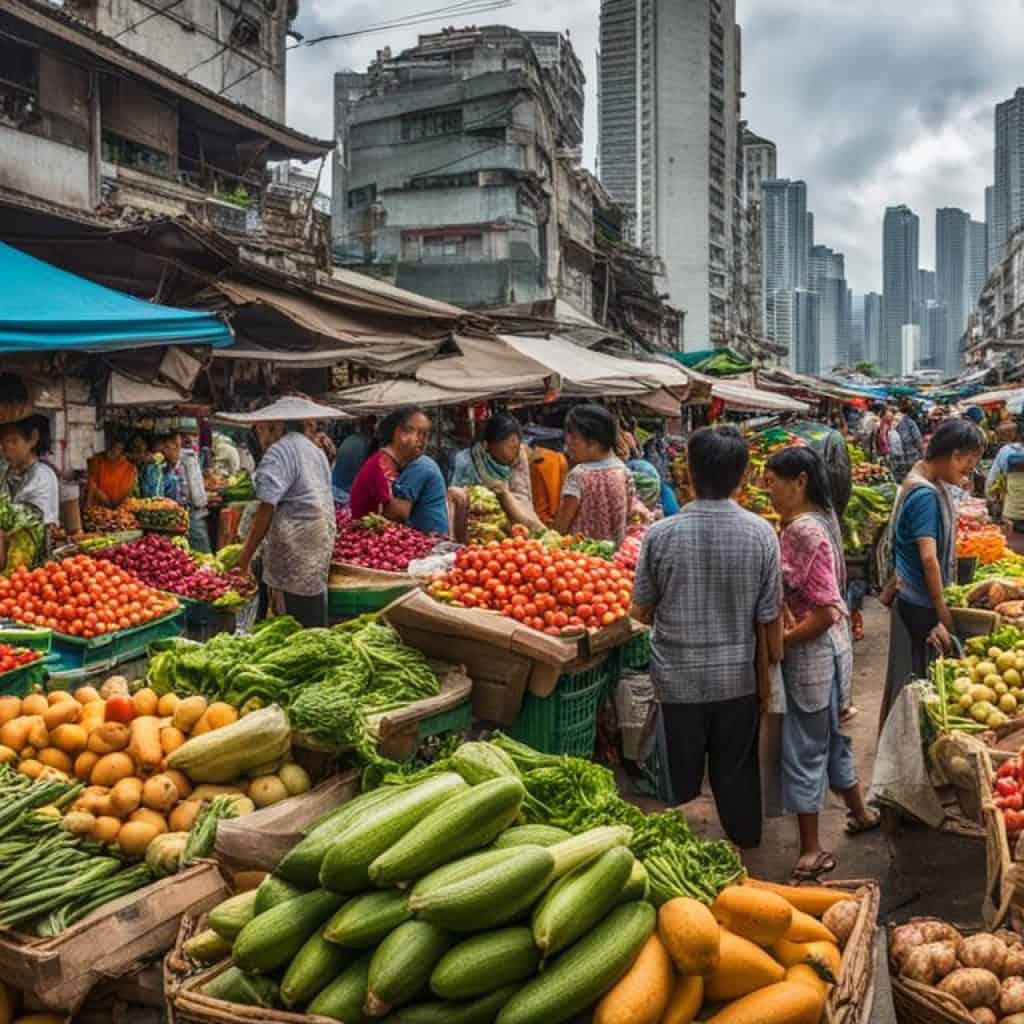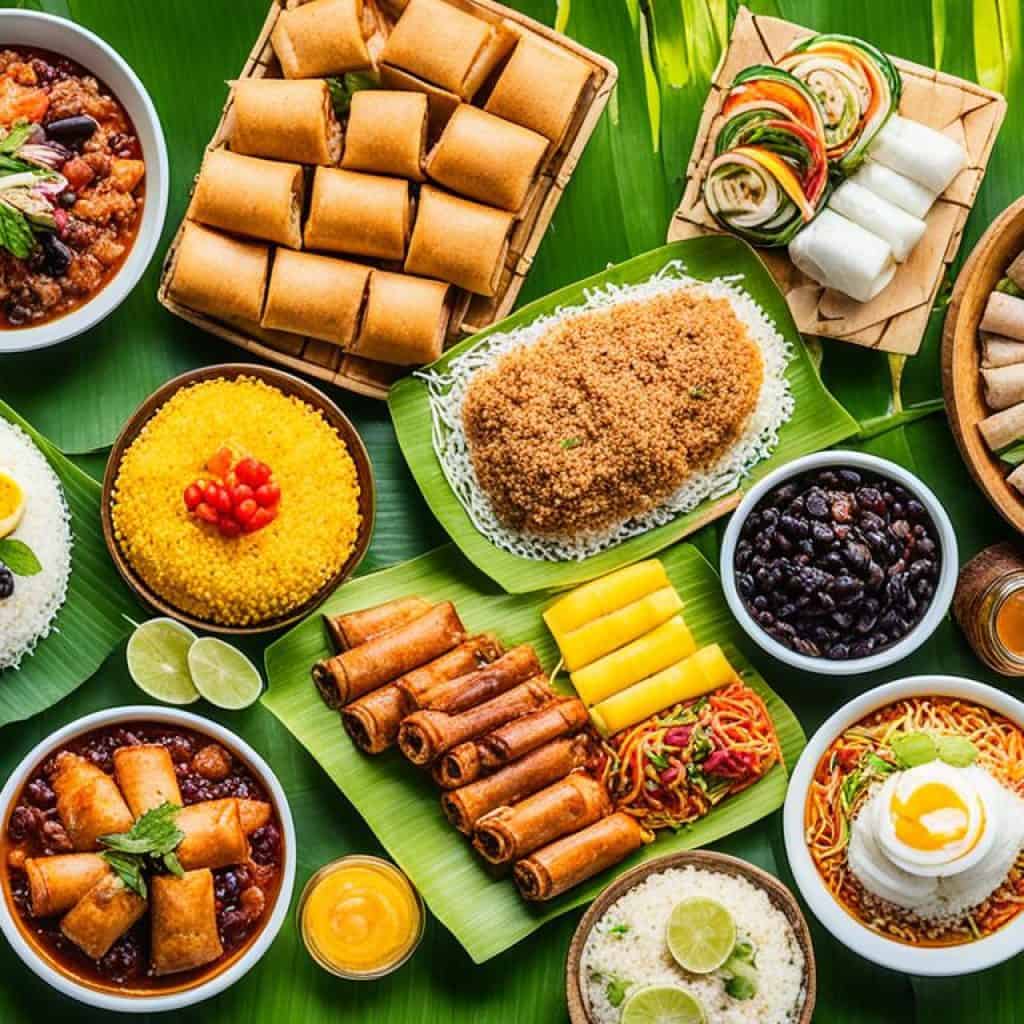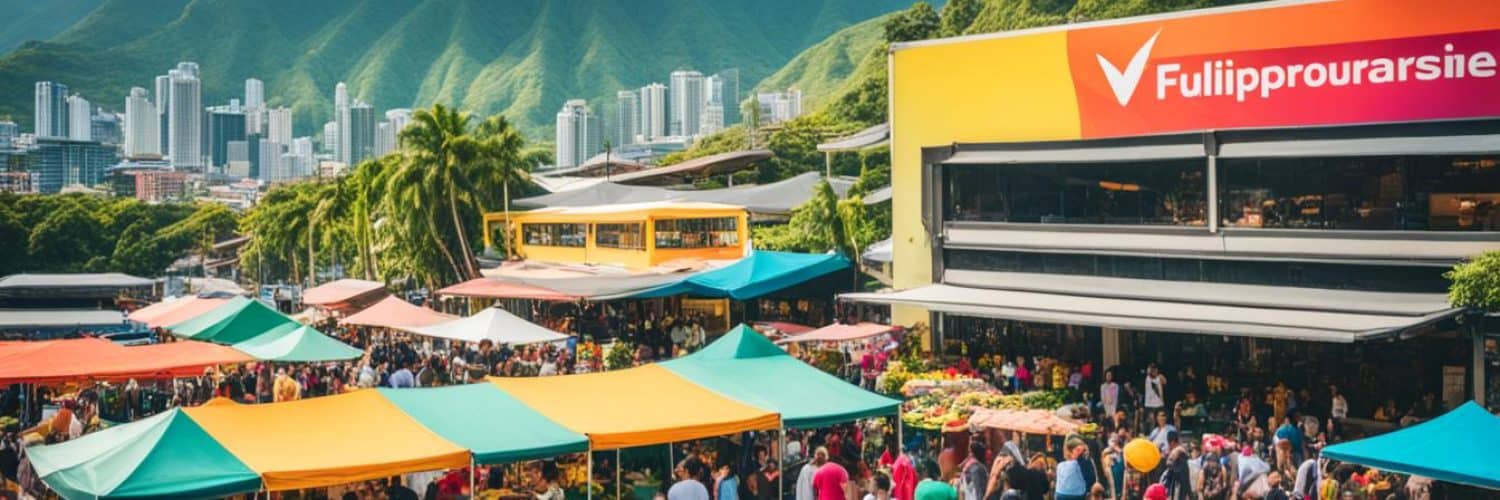Are you curious about what life in the Philippines will be like in 2024? Wondering how the Filipino lifestyle will evolve and what changes will shape the future of the country? Prepare to embark on a journey into the vibrant and colorful world of the Philippines, where optimism abounds and opportunities await.
As the Philippines emerges from the challenges brought on by the COVID-19 pandemic, the nation is embracing a hopeful outlook for the coming years. With an impressive economic growth rate and the resilient spirit of its people, the Philippines is set to welcome the future with open arms.
In this article, we will delve into what the year 2024 holds for expats living in the Philippines. From the best cities to live in and the richness of Philippine culture and traditions to the booming tourism industry and the allure of Manila’s attractions, we will provide you with insights and information to help you navigate and understand life in the Philippines in 2024.
Key Takeaways:
- Despite the challenges, Filipinos approach 2024 with hope and optimism.
- The Philippines offers an affordable cost of living, attracting expats from around the world.
- The warm hospitality of the locals makes it easy for expats to feel welcomed and integrated into the community.
- The country’s year-round warm weather and stunning beaches provide a tropical paradise for expats seeking a vibrant lifestyle.
- English is widely spoken in the Philippines, facilitating communication for expats.
Pros of Living in the Philippines
Living in the Philippines offers several advantages that make it a desirable destination for expats. Here are the key reasons why:
Affordable Cost of Living
The cost of living in the Philippines is significantly lower compared to western countries. Expats can enjoy affordable housing options and find basic commodities at cheaper prices, making it easier to manage expenses and maintain a comfortable lifestyle.
Friendly Locals
Year-Round Warm Weather
The Philippines boasts a tropical climate with year-round warm weather. This is particularly attractive for those seeking a sunny and beach-centric lifestyle. Whether it’s relaxing by the sea or exploring the lush landscapes, expats can enjoy the perks of a tropical paradise all year long.
Beautiful Beaches
The Philippines is renowned for its stunning beaches, offering picturesque shorelines and crystal-clear waters. From famous destinations like Boracay Beach to hidden gems like Samal Island, expats have endless opportunities to discover breathtaking beach locations and indulge in beachside living.
Diverse Food Options
Filipino cuisine is a fusion of flavors influenced by Southeast Asian and Spanish cultures. From traditional dishes to international cuisine, expats can explore a diverse culinary landscape. Whether it’s trying local delicacies or enjoying dishes from around the world, there’s something to satisfy every palate.
English Widely Spoken
Communication is a breeze for expats in the Philippines as English is widely spoken. Most Filipinos are fluent in English, making it easy to navigate daily life, interact with locals, and participate in various activities without language barriers.
Established Expat Community
The Philippines has an established expat community that provides support and networking opportunities. Expats can connect with like-minded individuals, share experiences, and find valuable resources to ease their transition into the Filipino lifestyle. The community offers a sense of belonging and a chance to make lifelong friendships.
Breathtaking Nature and Wildlife
Nature lovers will be captivated by the diverse landscapes and wildlife in the Philippines. From lush rainforests to majestic mountains, there are endless opportunities for outdoor adventures. Volcano climbing, rainforest trekking, and scuba diving are just a few activities that allow expats to explore the country’s breathtaking nature up close.
Accessible Public Transport
Cons of Living in the Philippines
While the Philippines offers many advantages, such as affordable living, friendly locals, and beautiful beaches, there are also some challenges expats should be aware of.
Crowded Cities and Traffic Issues
The major cities in the Philippines can be crowded and congested, leading to traffic problems and discomfort in public transportation. Navigating through the bustling streets can be challenging and time-consuming.
High Levels of Poverty and Unmaintained Infrastructure
The country has high levels of poverty, which can result in unmaintained infrastructure and poor living conditions in some areas. Dirty streets and inadequate public services may be common in certain neighborhoods.
High Crime Rate
The Philippines has a relatively high crime rate, and expats need to be cautious and take necessary safety measures to protect themselves and their belongings.
Poor Driving Conditions
Driving in the Philippines can be chaotic and risky due to the disregard for traffic rules and poor road conditions. Expats should exercise caution and be prepared for challenging driving experiences.
Inability to Own Property as an Expat
Threats of Terrorism and Natural Disasters
Air Pollution
Air pollution is a significant problem in urban areas of the Philippines. Expats with respiratory issues or sensitivity to pollution may find it challenging to cope with the poor air quality in certain parts of the country.
Affordable Cost of Living
One of the biggest advantages of living in the Philippines is the affordable cost of living. This Southeast Asian country offers a lower cost of living compared to western countries, making it an attractive destination for expats and retirees looking to stretch their budget. Let’s take a closer look at the affordable aspects of life in the Philippines.
Housing Prices in the Philippines
In the Philippines, housing prices are significantly lower than those in western countries. Whether you prefer a spacious house, a cozy apartment, or a condominium unit, there are options available to suit various budgets. Take a look at the table below for an overview of housing prices in popular cities:

Cost of Groceries in the Philippines
When it comes to grocery shopping, the cost of basic commodities in the Philippines is relatively lower compared to western countries. Local markets and supermarkets offer a wide range of fresh produce, pantry staples, and household products at affordable prices. Here are some examples of average prices for common grocery items:
- Dozen Eggs: $0.80
- 1 kg of Rice: $0.70
- 1 kg of Chicken Breasts: $2.00
- 1 liter of Milk: $1.50
- 1 loaf of Bread: $1.20
Dining Costs in the Philippines
Exploring the local cuisine and dining out in the Philippines can be a delicious and affordable experience. From street food stalls to restaurants, there are options to suit every budget. Here are some average prices for dining out:
- Meal at an Inexpensive Restaurant: $3.00
- Meal for Two at a Mid-Range Restaurant: $15.00
- McDonald’s Combo Meal: $4.00
- Cup of Cappuccino: $2.20
- Local Beer (0.5L): $1.50
With affordable housing options, lower grocery prices, and budget-friendly dining options, the cost of living in the Philippines offers excellent value for money. On average, a single person can expect to spend around $550 USD per month on living expenses, while a small family of four can expect to spend around $1900 USD per month. These affordable costs enable individuals and families to enjoy a comfortable lifestyle while saving for the future. Whether you’re a retiree looking for an affordable retirement destination or an expat seeking a new adventure, the Philippines offers an enticing and cost-effective option.
Friendly Locals
The Filipino people are known for their warmth and hospitality. The locals are not just acquaintances; they become friends who will make you feel like a part of their extended family. Embracing a festive and community-oriented culture, Filipinos are often open to accepting outsiders and are known for their kindness and generosity.
When you visit the Philippines, you’ll be greeted with genuine smiles, warm greetings, and an eagerness to help. Don’t be surprised if locals strike up conversations, share stories, and offer recommendations for places to visit or things to try. They take pride in showcasing their country and will make you feel at home.
Welcoming Culture in the Philippines
The welcoming culture in the Philippines is deeply rooted in the values and traditions of its people. Filipinos are known for their strong sense of community and family ties, which extends beyond blood relations. This sense of community creates a warm and inclusive environment for both locals and visitors.
“The Filipino concept of ‘bayanihan,’ which means community spirit or helping each other, is a true reflection of the welcoming culture in the Philippines. This spirit of cooperation and support is evident in various aspects of Filipino life,” explains Maria Santos, a local cultural anthropologist.
From festive celebrations to random acts of kindness, the Filipino people make a conscious effort to ensure that everyone feels accepted and valued. It is not uncommon for strangers to be invited to join in celebrations, share meals, or even stay in someone’s home. This unique culture of inclusivity and friendliness creates a memorable and enriching experience for all who visit or choose to live in the Philippines.
Year-Round Warm Weather
The Philippines is blessed with a tropical climate, providing year-round warm weather that is a major draw for those seeking a permanent tropical lifestyle. Whether you’re a beach lover or enjoy lush green landscapes, the Philippines offers the ideal climate to satisfy your desires.
In Manila, the capital city, the average temperatures range from the high 20s to low 30s degrees Celsius, creating a pleasant and comfortable environment for residents and visitors alike. This warm weather allows for outdoor activities and beach exploration throughout the year.
The country experiences both wet and dry seasons, ensuring a perfect mix of sunny beach days and refreshing rain showers. The wet season, typically from June to November, brings occasional rain showers and a vibrant green landscape, while the dry season, which lasts from December to May, offers clear skies and ample sunshine for beach enthusiasts.
Beautiful Beaches
The Philippines is renowned for its stunning beaches, attracting visitors from around the world. With thousands of breathtaking shorelines spread across its numerous islands, the country offers an abundance of beach destinations for expats and tourists to explore and enjoy. Whether you’re looking for relaxation, water sports, or simply a picturesque setting, the beautiful beaches in the Philippines have something for everyone.
Some of the most famous beaches in the Philippines include:
- Boracay Beach: Known for its powdery white sands and turquoise waters, Boracay Beach is often regarded as one of the best beaches in the world. It offers a vibrant and lively atmosphere with a range of activities such as snorkeling, parasailing, and beach parties.
- Samal Island: Located near Davao City, Samal Island is known for its serene and secluded beaches. With crystal clear waters and lush surroundings, it’s a perfect destination for those seeking tranquility and natural beauty.
- El Nido: Nestled in the northern part of Palawan, El Nido is famous for its dramatic limestone cliffs, clear lagoons, and pristine beaches. It is a haven for snorkelers, divers, and nature enthusiasts.
These are just a few examples of the many exquisite beach destinations in the Philippines. From secluded coves to bustling shores, there’s a beach to suit every preference. Expats and visitors can discover hidden gems off the beaten path or indulge in the vibrant beach culture of well-known destinations. No matter where you go, the beautiful beaches in the Philippines will leave you in awe of their natural splendor.
The Food
Filipino cuisine offers a tantalizing fusion of Southeast Asian and Spanish influences, resulting in a diverse array of flavorful dishes. The culinary landscape in the Philippines is a delightful blend of rich spices, unique cooking techniques, and a passion for fresh ingredients.
Popular Dishes in the Philippines
When it comes to Filipino cuisine, there are several iconic dishes that are beloved by locals and visitors alike. These include:
- Adobo: A savory dish made with tender meat (commonly chicken or pork) marinated in a tangy soy and vinegar sauce.
- Sinigang: A comforting soup with a sour broth, typically made with fish, pork, or shrimp and flavored with tamarind.
- Lechon: A festive centerpiece featuring a whole roasted pig, prized for its crispy skin and succulent meat.
- Kare-Kare: A rich stew made with oxtail and vegetables, simmered in a peanut-based sauce.
- Pancit: A variety of noodle dishes that come in different regional styles, with influences from Chinese cuisine.
- Halo-Halo: A refreshing dessert consisting of a mix of sweet ingredients such as shaved ice, sweet beans, jellies, and fruits, topped with evaporated milk and leche flan.
These dishes highlight the diverse culinary heritage of the Philippines and showcase the creativity and passion that go into every meal.
International Food Options in the Philippines
“The Philippines not only embraces its own rich culinary heritage, but also welcomes international flavors with open arms.”
If you have diverse dietary preferences or simply crave flavors from around the world, the Philippines offers a myriad of international food options. In areas with a thriving expat community, you can find a wide range of cuisines, including Italian, Japanese, Indian, Mexican, and more. From trendy fusion restaurants to well-established eateries, the choices are endless.
For those with specific dietary restrictions, there are also vegan, halal, and kosher restaurants available. These establishments cater to the needs of individuals who follow specific dietary guidelines, ensuring that everyone can savor the tastes of the Philippines.
Exploring Filipino Cuisine
When living in the Philippines, it’s not just about enjoying the popular dishes; it’s also about embracing the local food culture and discovering hidden culinary gems. Exploring local markets, street food stalls, and traditional eateries is a must for a truly immersive experience.
One popular destination for food enthusiasts is the famous “Mercato Centrale” in Manila. This bustling night market showcases a vibrant mix of street food vendors and up-and-coming chefs, offering a wide range of Filipino delicacies and international-inspired dishes.

| Dish | Main Ingredients | Description |
|---|---|---|
| Adobo | Chicken, pork, or both | A tangy and flavorful dish marinated in soy sauce, vinegar, garlic, and spices. |
| Sinigang | Fish, pork, or shrimp | A sour soup made with tamarind as the base flavoring, accompanied by vegetables. |
| Lechon | Whole roasted pig | A festive centerpiece known for its crispy skin and tender meat. |
| Kare-Kare | Oxtail and vegetables | A rich and creamy stew made with peanut sauce. |
| Pancit | Noodles, meat, and vegetables | A variety of noodle dishes, each with its own unique blend of flavors. |
| Halo-Halo | Shaved ice, sweet beans, jellies, fruits | A refreshing dessert with a colorful mix of sweet ingredients topped with evaporated milk. |
English is Widely Spoken
When it comes to communication in the Philippines, expats can rest assured that the English language plays a vital role in bridging the language barrier. English is widely spoken throughout the country, making it easy for expats to connect and interact with the locals. Whether it’s ordering food at a restaurant, asking for directions, or engaging in day-to-day conversations, English proficiency ensures a smooth and hassle-free experience.
Most Filipinos can speak English fluently, which is reflected in various aspects of daily life. Important signage, government forms, and even business transactions are often conducted in English. This linguistic advantage greatly eases the transition for expats and facilitates a deeper understanding of the local culture.
While it is helpful to have some knowledge of the Filipino language, expats can confidently rely on their English skills to navigate through various situations. The ability to communicate effectively in English opens doors for meaningful connections and fosters a sense of belonging in the vibrant Filipino community.
English Language Proficiency in the Philippines
The proficiency of English in the Philippines can be attributed to a number of historical and cultural factors. The country was once a colony of the United States, which led to English being introduced as a medium of instruction in schools and as an official language. Additionally, the prevalence of American pop culture, such as movies, music, and television shows, has further contributed to the widespread use and understanding of the English language.
“English is not just used as a language of communication in the Philippines; it is a reflection of our identity as a globally connected nation. It allows us to engage with the international community, attract business investments, and bridge cultural gaps.”
The English language is also an integral part of the educational system in the Philippines. English is taught as a core subject from primary school to college, ensuring that Filipinos have a strong foundation in the language. This dedication to English proficiency sets the Philippines apart as an ideal destination for expats seeking seamless communication and integration.
Benefits of English Proficiency for Expats
For expats relocating to the Philippines, the widespread use of English offers a multitude of advantages. It eliminates the language barrier, making it easier to adapt to the local culture and connect with the community. Expats can confidently engage in social, professional, and personal interactions without feeling isolated or misunderstood.
Furthermore, English proficiency opens up countless opportunities for career growth and networking. Expats can easily explore job prospects in various industries, as many companies conduct business and operate in English. Networking events, professional organizations, and online communities provide avenues for expats to expand their connections and build a strong support system.
| Benefits of English Language Proficiency for Expats |
|---|
| Easy communication and understanding with locals |
| Effortless navigation of important signage, government forms, and business transactions conducted in English |
| Inclusion in social, professional, and personal interactions |
| Expanded career opportunities and networking prospects |
While it is always beneficial to learn and appreciate the local language, the prevalence of English in the Philippines ensures that expats can confidently embrace their new life with ease and comfort. With English as a common ground, expats are empowered to fully immerse themselves in the vibrant Filipino culture and create lasting memories.
Has an Established Expat Community
The Philippines is home to a vibrant and well-established expat community. Expats from all over the world have chosen to make the Philippines their new home, creating a diverse and supportive community. This community provides a wealth of networking opportunities, allowing expats to connect with like-minded individuals who have gone through similar lifestyle changes.
Being part of the expat community in the Philippines offers more than just social connections. It serves as a valuable source of support, guidance, and a way to combat homesickness. Expats can rely on the community for assistance in navigating the challenges of living in a new country, whether it’s finding housing, understanding local customs, or accessing essential services.
One of the greatest advantages of the expat community is the sense of belonging it provides. Expats can find comfort in knowing that they are not alone in their journey. They can share experiences, exchange tips, and learn from one another, creating a strong support system that eases the transition into expat life in the Philippines.
The Power of Networking
Networking is an essential component of success in any endeavor, and the expat community in the Philippines offers ample opportunities for professional and personal networking. Expats can connect with individuals from various industries and backgrounds, opening doors to potential job prospects, business partnerships, and collaboration opportunities.
Networking events organized by the expat community provide a platform to meet fellow professionals, entrepreneurs, and experts in various fields. These events foster meaningful connections and friendships that can contribute to personal and professional growth.
“The expat community in the Philippines has been instrumental in helping me establish my business and expand my professional network. The support and insights I have gained from fellow expats have played a significant role in my success.” – John, expat entrepreneur
Engaging Social Activities
The expat community in the Philippines is also known for organizing a wide range of social activities and events. From cultural celebrations to sports tournaments and charity fundraisers, there is always something happening that allows expats to engage with the community and create lasting memories.
These social activities not only provide opportunities for fun and camaraderie but also create a sense of belonging and inclusion. Expats can participate in cultural exchange programs, join clubs tailored to their interests and hobbies, and actively contribute to the local community.
Overall, being part of the established expat community in the Philippines offers a multitude of benefits. It provides a supportive network, valuable networking opportunities, engaging social activities, and a sense of belonging. Expats can thrive in an environment where they can connect with others, share experiences, and build a fulfilling life in their new home.
Breathtaking Nature and Wildlife
The Philippines is a nature lover’s paradise, offering a stunning array of diverse landscapes and abundant wildlife. From lush rainforests to towering mountains and vibrant coral reefs, the country is brimming with natural attractions waiting to be explored.
With its countless islands, the Philippines is home to a vast range of unique ecosystems. Whether you’re interested in tropical rainforest exploration, thrilling volcano climbing adventures, or underwater escapades in crystal-clear waters, there is something for everyone.
One of the most popular activities among expats and visitors is volcano climbing. The Philippines is part of the Pacific Ring of Fire, and its volcanic landscape provides opportunities for thrilling hikes and breathtaking views. Mount Mayon, Taal Volcano, and Mount Pinatubo are just a few examples of the picturesque volcanoes that attract adventurers from around the world.
For those who prefer to explore the enchanting rainforests, rainforest trekking is a must. Immerse yourself in the lush greenery, listen to the chorus of exotic birds, and discover hidden waterfalls as you navigate through the trails. Some popular rainforest destinations include the Bicol Rainforest in Luzon and the forests of Bohol and Palawan.
Outdoor Activities in the Philippines:
- Volcano climbing
- Rainforest trekking
- Scuba diving
- Island hopping
- Snorkeling
- Whale watching
- River cruising
- Kayaking
Whether you’re an adrenaline junkie seeking thrilling adventures or a nature enthusiast seeking tranquility, the Philippines offers endless opportunities for outdoor activities and weekend getaways.

Top Natural Attractions in the Philippines:
| Attraction | Description |
|---|---|
| Banaue Rice Terraces | A UNESCO World Heritage Site, these breathtaking rice terraces were carved into the mountains more than 2,000 years ago by the indigenous Ifugao people. |
| Chocolate Hills | Located in Bohol, these unique geological formations consist of over 1,000 grass-covered limestone hills that turn chocolate brown during the dry season. |
| Tubbataha Reefs Natural Park | A UNESCO World Heritage Site, this marine park is a sanctuary for hundreds of marine species and offers outstanding diving opportunities. |
| El Nido | A stunning destination in Palawan, El Nido is known for its turquoise waters, limestone cliffs, and hidden lagoons, making it a haven for beach lovers. |
| Mayon Volcano | With its perfect cone shape, Mount Mayon in Albay province is one of the most picturesque volcanoes in the world and a popular spot for hiking and photography. |
Traffic Conditions and Road Risks
When it comes to traffic conditions, the Philippines, especially major cities like Manila, is notorious for its congestion and lack of traffic discipline. Navigating through the city streets can often be a challenging and frustrating experience for both locals and expats alike. Overcrowded public transportation only adds to the chaos, making it difficult to reach your destination on time.
Driving in the Philippines can be particularly challenging due to poor road conditions and reckless driving behavior. Potholes and uneven surfaces can make for a bumpy ride, while drivers frequently disregard traffic rules, including speeding and improper lane usage. It’s important to exercise caution and be prepared for the risks associated with driving in this country.
“The traffic in Manila can be overwhelming, especially during rush hour. It’s not uncommon to spend hours stuck in gridlock. It’s always a good idea to plan your journeys ahead of time and consider alternative transportation options.”
For expats living in the Philippines, it’s advisable to explore alternative transportation options to avoid the hassle of driving in heavy traffic. Public transportation, such as buses and trains, although crowded at times, can be a cost-effective and convenient way to get around. Ride-hailing services like Grab and Angkas also offer a reliable means of transportation.
It’s important to be aware of the potential road risks and delays that come with navigating the Philippines’ roads. Staying alert, following traffic rules, and practicing defensive driving can help mitigate some of the risks. Additionally, keeping updated on traffic news and using navigation apps can provide valuable information on road conditions and alternative routes.
The table below highlights the current transportation options in the Philippines:
| Transportation Option | Pros | Cons |
|---|---|---|
| Public Transportation |
|
|
| Ride-Hailing Services |
|
|
| Driving |
|
|
Ultimately, the choice of transportation will depend on various factors, including personal comfort, convenience, and the specific location. It’s important to weigh the pros and cons and choose the option that best suits your needs and preferences.
Conclusion
Life in the Philippines in 2024 offers a vibrant and colorful lifestyle, with a unique blend of affordability, warm hospitality, and stunning natural beauty. Despite challenges such as crowded cities, high crime rates, and the risk of natural disasters, the advantages of living in the country outweigh the cons for many expats.
The strong sense of community in the Philippines is one of its greatest assets. The friendly locals embrace expats with open arms, making it easy to form connections and feel at home. The year-round warm weather and beautiful beaches add to the allure, providing opportunities for leisure and relaxation.
Furthermore, the diverse culinary experiences in the Philippines are a delight for food lovers. The fusion of Southeast Asian and Spanish influences creates a rich and flavorful cuisine. English is widely spoken, facilitating communication and easing the transition for expats.
Looking towards the future of the Philippines, the country’s resilience and positive outlook remain strong. With a recovering economy and a hopeful population, the Philippines continues to be an attractive destination for those seeking a vibrant and fulfilling life. Despite its challenges, the Philippines offers a unique lifestyle that combines affordability, rich culture, and breathtaking natural wonders.
FAQ
What are the advantages of living in the Philippines?
The advantages of living in the Philippines include affordable cost of living, friendly locals, year-round warm weather, beautiful beaches, diverse food options, English widely spoken, established expat community, breathtaking nature and wildlife, and accessible public transport.
What are the challenges of living in the Philippines?
The challenges of living in the Philippines include crowded cities, high levels of poverty, high crime rate, poor driving conditions, inability to own property as an expat, threats of terrorism, risk of natural disasters, and air pollution.
How affordable is the cost of living in the Philippines?
The cost of living in the Philippines is significantly lower compared to western countries. Housing prices are affordable, and basic groceries and dining out are more affordable as well. On average, a single person can expect to spend around $550 USD per month on living expenses, while a small family of four can expect to spend around $1900 USD per month.
Are the locals in the Philippines friendly towards expats?
Yes, the locals in the Philippines are known for their warmth and hospitality. They are generally friendly and welcoming towards expats, making it easy to integrate into the community. The Filipino culture embraces a festive and community-oriented mindset, where outsiders are often accepted with kindness and generosity.
What is the weather like in the Philippines?
The Philippines offers a tropical climate with year-round warm weather. The average temperatures in Manila range from high 20s to low 30s degrees Celsius. The country experiences a wet and dry season, providing a combination of beach weather and lush landscapes throughout the year.
What are some popular beach destinations in the Philippines?
What is the cuisine like in the Philippines?
Filipino cuisine is a fusion of Southeast Asian and Spanish influences, resulting in a variety of flavorful dishes. The cuisine heavily features meat, particularly chicken, pork, and beef. However, there are also options for those with dietary preferences, including vegan, halal, and kosher restaurants in areas with international communities. Expats can indulge in a diverse culinary experience and explore the local food culture.
Is English widely spoken in the Philippines?
Yes, English is widely spoken in the Philippines. Most Filipinos can speak English, and important signage, government forms, and business transactions are often conducted in English. While it is advantageous to have some knowledge of the Filipino language, English proficiency ensures a smooth transition and daily life in the country.
Is there an established expat community in the Philippines?
Yes, the Philippines has a well-established expat community, providing support and networking opportunities. Expats can connect with like-minded individuals who have gone through similar lifestyle changes. This community serves as a source of assistance, guidance, and a way to combat homesickness. Expats can also participate in various social activities and events organized by the community.
What are some outdoor activities to enjoy in the Philippines?
The Philippines is a paradise for nature lovers, offering diverse landscapes and abundant wildlife. From rainforests to mountains and coral reefs, there is no shortage of natural attractions to explore. Activities such as volcano climbing, rainforest trekking, and scuba diving are popular among expats and visitors. The country provides endless opportunities for outdoor adventures and weekend getaways.
What are the traffic conditions like in the Philippines?
The Philippines has notorious traffic conditions, particularly in major cities like Manila. Congestion, lack of traffic discipline, and overcrowded public transportation are common issues. Driving in the Philippines can be challenging due to poor road conditions and reckless driving behavior. Expats should consider alternative transportation options or be prepared for potential road risks and delays.


















Add comment